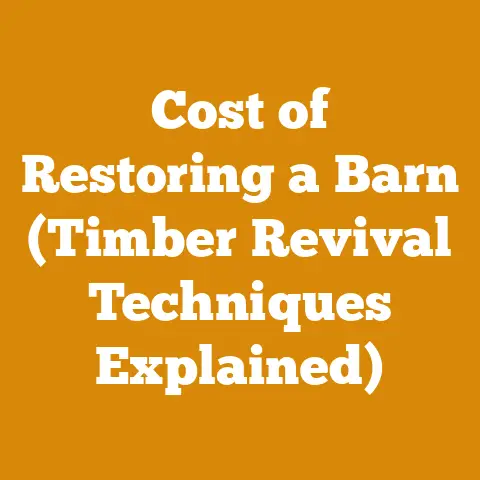How to Determine Tree Height (Pro Tips for Precision Measuring)
Okay, let’s dive into the fascinating world of tree height measurement. A quick fix? Eyeballing it! But, of course, we want precision, especially when safety, timber yield, or even just bragging rights are on the line.
How to Determine Tree Height: Pro Tips for Precision Measuring
Knowing how to accurately measure tree height is crucial in various aspects of wood processing, logging, and even firewood preparation. It impacts everything from timber yield estimation and safe felling practices to determining the suitability of a tree for specific purposes, like lumber production or firewood. Often, a rough estimate just won’t cut it, and that’s where precise measurement techniques come into play.
I’ve spent years in the woods, from helping manage family land to working with small-scale logging operations. I’ve seen firsthand how critical accurate tree height measurements are. A miscalculation can lead to underestimating the amount of usable timber, misjudging the felling zone, or even selecting the wrong tree for a specific project. Let’s get into the details.
Why Precise Tree Height Measurement Matters
Before we get into the “how,” let’s discuss the “why.”
- Timber Volume Estimation: Accurate height combined with diameter at breast height (DBH) is essential for estimating timber volume. This is critical for determining the market value of a tree or stand of trees.
- Felling Safety: Knowing a tree’s height is crucial for planning a safe felling operation. It helps determine the potential felling zone and identify potential hazards.
- Tree Health Assessment: Tree height, when compared to its species’ average height, can be an indicator of tree health and growth rate. Stunted growth might signal underlying problems.
- Land Management: Understanding tree height distributions within a forest stand is valuable for informed land management decisions, such as thinning or selective harvesting.
- Firewood Calculations: While not as critical as in logging, knowing the approximate height of a tree before felling it for firewood can help estimate the potential yield and plan the bucking process.
Key Terms and Concepts
Let’s define some key terms to ensure we’re all on the same page:
- Tree Height: The vertical distance from the base of the tree to its highest point.
- DBH (Diameter at Breast Height): The diameter of the tree trunk measured at 4.5 feet (1.37 meters) above the ground. This is a standard measurement used in forestry.
- Slope: The angle of the ground relative to the horizontal. This is important when measuring tree height on sloping terrain.
- Clinometer: An instrument used to measure angles of elevation and depression.
- Hypsometer: A device specifically designed to measure tree height, often incorporating a clinometer or laser rangefinder.
- Green Wood: Freshly cut wood that has a high moisture content. This wood is heavier and more difficult to split than seasoned wood.
- Seasoned Wood: Wood that has been dried to reduce its moisture content. Seasoning makes wood lighter, easier to burn, and less prone to rot.
Simple Methods for Estimating Tree Height
Sometimes, you need a quick estimate rather than a precise measurement. Here are a couple of simple methods:
The Stick Method
This method relies on similar triangles.
- Hold a stick: Hold a stick vertically at arm’s length.
- Adjust the stick: Adjust the stick so that the portion of the stick above your hand appears to be the same height as the tree.
- Measure the distance: Measure the distance from your eye to the base of the stick. This distance is approximately equal to the height of the tree.
Limitations: This method is highly subjective and prone to error, especially over long distances or on sloping ground. It’s best used for rough estimations only.
The Pencil Method
Similar to the stick method, this uses a pencil or any small object.
- Hold the pencil: Hold the pencil vertically at arm’s length.
- Align with tree: Close one eye and adjust the pencil until the tip aligns with the top of the tree and your thumb aligns with the base of the tree.
- Rotate the pencil: Rotate the pencil 90 degrees so it’s horizontal.
- Estimate the distance: Have a partner walk away from the tree at a right angle until they appear to be the same height as the horizontal pencil. The distance from the base of the tree to your partner is approximately the height of the tree.
Limitations: This method is also prone to error and works best on relatively flat ground.
Precise Methods for Measuring Tree Height
For accurate measurements, we need to use tools and techniques that account for distance, angle, and slope.
Using a Clinometer
A clinometer is a handheld instrument that measures angles of elevation and depression. There are several types of clinometers, including:
- Suunto Clinometer: A popular and reliable optical clinometer.
- Digital Clinometer: Offers digital readings and can often store measurements.
- Smartphone Apps: Many smartphone apps mimic the functionality of a clinometer.
Steps for Using a Clinometer:
- Measure the Distance: Measure the distance from the tree. This is your baseline. A good rule of thumb is to use a distance roughly equal to the estimated height of the tree.
- Tip: Use a measuring tape or a laser rangefinder for accurate distance measurement.
- Measure the Angle to the Top: Stand at your measured distance from the tree. Aim the clinometer at the top of the tree and record the angle of elevation.
- Measure the Angle to the Base: Aim the clinometer at the base of the tree and record the angle of depression. If you are on level ground, this angle will be zero.
-
Calculate the Tree Height:
- On Level Ground: Tree Height = Distance * tan(Angle to Top)
-
On Sloping Ground: Tree Height = (Distance * tan(Angle to Top)) + (Distance * tan(Angle to Base))
-
Example: Let’s say you are 50 feet from the tree. The angle to the top is 40 degrees, and the angle to the base is 5 degrees.
- Tree Height = (50 * tan(40°)) + (50 * tan(5°))
- Tree Height = (50 * 0.839) + (50 * 0.087)
- Tree Height = 41.95 + 4.35
- Tree Height = 46.3 feet
Accounting for Eye Height:
It’s important to account for your eye height when using a clinometer. This is the distance from the ground to your eye when holding the clinometer. Add your eye height to the calculated tree height for a more accurate measurement.
- Example: If your eye height is 5.5 feet, the corrected tree height would be 46.3 + 5.5 = 51.8 feet.
Personal Experience: I remember once, while working on a timber cruise in the Pacific Northwest, I consistently underestimated tree heights because I forgot to account for my eye height. This led to a significant underestimation of the total timber volume for the stand. It was a valuable lesson in the importance of meticulousness.
Using a Laser Rangefinder with Height Measurement Capabilities
Laser rangefinders with height measurement capabilities are becoming increasingly popular. These devices use lasers to measure the distance to the top and bottom of the tree, and then use trigonometry to calculate the height.
Steps for Using a Laser Rangefinder:
- Aim at the Top: Aim the laser rangefinder at the top of the tree and take a measurement.
- Aim at the Base: Aim the laser rangefinder at the base of the tree and take a measurement.
- The Device Calculates Height: The laser rangefinder will automatically calculate and display the tree height.
Advantages of Laser Rangefinders:
- Accuracy: Laser rangefinders are generally more accurate than clinometers, especially over long distances.
- Ease of Use: They are relatively easy to use, requiring minimal training.
- Speed: They can measure tree height quickly and efficiently.
Disadvantages of Laser Rangefinders:
- Cost: Laser rangefinders can be expensive.
- Obstructions: Dense foliage can sometimes interfere with the laser beam.
- Battery Dependence: Requires batteries, which can fail in the field.
Case Study: I recently used a laser rangefinder to measure tree heights in a mixed hardwood forest in Pennsylvania. The forest had a dense understory, which made it difficult to use a clinometer accurately. The laser rangefinder allowed me to quickly and accurately measure the tree heights, even with the obstructions. I was able to complete the timber inventory much faster than I would have been able to with a clinometer.
Using a Hypsometer
A hypsometer is a specialized instrument designed specifically for measuring tree height. Some hypsometers combine a clinometer with a rangefinder, while others use different principles.
Types of Hypsometers:
- Suunto Height Meter: This hypsometer uses a scale that is viewed through an eyepiece. The user aligns the scale with the top and base of the tree, and the height is read directly from the scale.
- Haga Hypsometer: Similar to the Suunto Height Meter, but with a different scale design.
- Vertex Hypsometer: This hypsometer uses ultrasonic technology to measure distance and angle, and then calculates the height.
Steps for Using a Hypsometer:
The specific steps will vary depending on the type of hypsometer. However, the general process is:
- Measure the Distance: Measure the distance from the tree.
- Align the Instrument: Align the hypsometer with the top and base of the tree.
- Read the Height: Read the tree height directly from the instrument.
Advantages of Hypsometers:
- Convenience: Designed specifically for tree height measurement.
- Relatively Accurate: Can provide accurate measurements with proper use.
Disadvantages of Hypsometers:
- Cost: Can be more expensive than a simple clinometer.
- Learning Curve: Some hypsometers can take some practice to use effectively.
Practical Considerations for Tree Height Measurement
Here are some practical considerations to keep in mind when measuring tree height:
- Obstructions: Be aware of obstructions that may interfere with your line of sight to the top or base of the tree.
- Tree Lean: If the tree is leaning, try to measure the height along the lean. Alternatively, you can measure the height of the vertical projection of the tree.
- Topography: Account for changes in topography. If you are measuring tree height on a steep slope, you may need to break the measurement into smaller segments.
- Weather Conditions: Windy conditions can make it difficult to get accurate measurements.
- Calibration: Regularly calibrate your instruments to ensure accuracy.
Tree Species and Measurement Challenges
Different tree species present unique challenges when measuring height.
- Deciduous Trees (e.g., Oak, Maple): In the dormant season, the lack of leaves makes it easier to see the top of the tree. However, identifying the true top can be challenging if branches are broken or distorted.
- Coniferous Trees (e.g., Pine, Fir): The pointed tops of conifers generally make them easier to measure. However, dense foliage can sometimes obscure the top.
- Trees with Irregular Crowns: Trees with broken tops, multiple leaders, or irregular crowns can be difficult to measure accurately. In these cases, it’s important to define what you consider to be the “top” of the tree.
Tools and Equipment for Tree Height Measurement
Here’s a rundown of essential tools and equipment:
- Clinometer: For measuring angles of elevation and depression. (Cost: $50 – $500)
- Laser Rangefinder: For measuring distance and height. (Cost: $200 – $2000)
- Hypsometer: A specialized instrument for measuring tree height. (Cost: $100 – $1000)
- Measuring Tape: For measuring distance from the tree. (Cost: $20 – $50)
- Compass: For navigation and determining direction. (Cost: $15 – $100)
- GPS Device: For recording locations and creating maps. (Cost: $100 – $500)
- Field Notebook and Pencil: For recording measurements and observations. (Cost: $5 – $10)
- Safety Gear: Hard hat, safety glasses, and appropriate footwear. (Cost: $50 – $150)
Tree Felling and Height Considerations
Tree height plays a critical role in safe and efficient tree felling.
- Felling Zone: The felling zone is the area around the tree that could be struck if the tree falls unexpectedly. The height of the tree is a primary factor in determining the size of the felling zone.
- Back Lean: Back lean is the angle at which the tree leans away from the intended direction of fall. The greater the back lean, the more difficult it will be to fell the tree in the desired direction. Accurate height measurement helps assess back lean.
- Lean Angle Calculation: The lean angle can be estimated using a clinometer. Measure the angle from the vertical to the tree’s trunk.
- Hinge Wood: The hinge wood is the portion of the tree that remains uncut and controls the direction of fall. The size and placement of the hinge wood are critical for safe felling.
- Felling Techniques: Different felling techniques are appropriate for different tree sizes and lean angles. For example, a simple back cut and felling cut may be sufficient for a small, straight tree. However, a more complex technique, such as a Humboldt cut or a bore cut, may be necessary for a larger or leaning tree.
- Chainsaw Selection: Chainsaw selection is based on tree diameter, not height directly, but height informs the overall size and type of tree you’re dealing with. For felling larger trees (over 20 inches in diameter), I prefer a chainsaw with a bar length of at least 20 inches and an engine displacement of 60cc or greater. My go-to is often my Stihl MS 362 C-M. For smaller trees, a lighter chainsaw with a shorter bar length may be sufficient.
- Felling Wedges: Felling wedges are used to help push the tree over in the desired direction. The size and number of wedges needed will depend on the size and lean of the tree.
- Pulling Systems: In some cases, it may be necessary to use a pulling system, such as a winch or a cable puller, to help fell the tree in the desired direction.
- Safety Protocols: Always follow established safety protocols when felling trees. Wear appropriate safety gear, clear the felling zone, and be aware of your surroundings.
Personal Story: I once witnessed a near-miss during a felling operation where the tree was significantly taller than estimated. The felling zone was not cleared adequately, and the tree fell dangerously close to a skidder. Fortunately, no one was hurt, but it highlighted the importance of accurate height measurement and careful planning.
Tree Height in Firewood Preparation
While not as directly crucial as in logging, tree height plays a role in firewood preparation.
- Estimating Firewood Yield: Knowing the approximate height of a tree can help you estimate the amount of firewood it will yield.
- Bucking Lengths: Tree height influences the optimal bucking lengths for firewood. Longer logs are easier to handle with machinery, while shorter logs are easier to split and stack manually. I generally buck firewood into lengths of 16-18 inches, which are suitable for most wood stoves and fireplaces.
- Log Splitter Selection: The size and type of log splitter you need will depend on the diameter and length of the logs you are splitting. For splitting larger logs (over 12 inches in diameter), I recommend a hydraulic log splitter with a splitting force of at least 20 tons. My personal preference is a 25-ton hydraulic splitter. For smaller logs, a manual log splitter or a maul may be sufficient.
- Splitting Techniques: Different splitting techniques are appropriate for different types of wood. For example, straight-grained wood is relatively easy to split, while knotty or twisted wood can be more challenging.
- Wood Stacking: Proper wood stacking is essential for efficient drying. Stack the wood in a single row, with the bark facing up. Leave space between the rows for air circulation.
- Drying Time: The drying time for firewood will vary depending on the species of wood, the climate, and the stacking method. Generally, it takes at least six months to season firewood properly. Hardwoods, such as oak and maple, typically take longer to season than softwoods, such as pine and fir.
- Moisture Content: Aim for a moisture content of 20% or less for optimal burning. Use a moisture meter to check the moisture content of the wood before burning it.
- Wood Types: Hardwoods are generally preferred for firewood because they burn hotter and longer than softwoods. However, softwoods can be useful for kindling. My favorite firewood species include oak, maple, ash, and hickory.
- Hydraulic Splitter Efficiency: Using a hydraulic log splitter significantly increases efficiency compared to manual splitting. A hydraulic splitter can split a cord of wood in a fraction of the time it would take to split it manually.
- Manual Splitting Considerations: When splitting wood manually, use a sharp maul and wear appropriate safety gear, including safety glasses and gloves.
Case Study: I once helped a friend prepare firewood for the winter using a combination of manual and hydraulic splitting. We started by bucking the logs into 16-inch lengths using a chainsaw. Then, we used a hydraulic splitter to split the larger logs and a maul to split the smaller logs. We stacked the wood in single rows, leaving space between the rows for air circulation. By the end of the day, we had split and stacked enough wood to last through the winter.
Data and Statistics in Wood Processing
Data and statistics are increasingly important in modern wood processing.
- Timber Inventory: Accurate timber inventory data, including tree height, diameter, and species, is essential for sustainable forest management.
- Yield Prediction: Tree height and diameter data can be used to predict timber yield.
- Growth Modeling: Tree height data can be used to model forest growth and predict future timber supply.
- Market Analysis: Market analysis data, including timber prices and demand, can be used to make informed decisions about harvesting and processing.
- Operational Efficiency: Data on operational efficiency, such as felling rates and processing times, can be used to improve productivity and reduce costs.
Strategic Advantages of Accurate Tree Height Measurement
- Informed Decision-Making: Accurate tree height measurement provides the data needed for informed decision-making in all aspects of wood processing, logging, and firewood preparation.
- Increased Efficiency: Accurate measurements can lead to increased efficiency and reduced waste.
- Improved Safety: Accurate height measurement is essential for safe felling operations.
- Sustainable Forest Management: Accurate timber inventory data is essential for sustainable forest management.
- Increased Profitability: By optimizing harvesting and processing operations, accurate measurements can lead to increased profitability.
Next Steps and Implementation Guidance
Ready to put these pro tips into practice? Here’s how to get started:
- Choose Your Method: Select the tree height measurement method that is best suited to your needs and budget.
- Gather Your Tools: Gather the necessary tools and equipment.
- Practice: Practice measuring tree height in a variety of settings.
- Record Your Measurements: Keep accurate records of your measurements.
- Analyze Your Data: Analyze your data to identify trends and patterns.
- Apply Your Knowledge: Apply your knowledge to improve your wood processing, logging, or firewood preparation operations.
By following these steps, you can become proficient in tree height measurement and improve the efficiency, safety, and sustainability of your wood processing operations. Remember, practice makes perfect. The more you measure, the more accurate you’ll become. And always prioritize safety!






